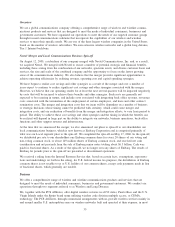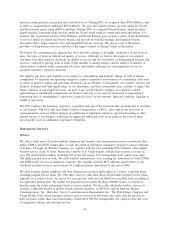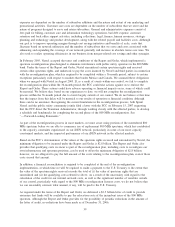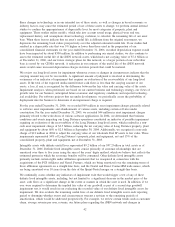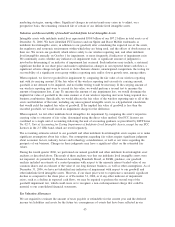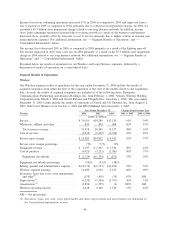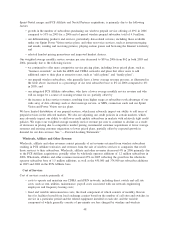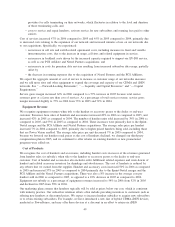Sprint - Nextel 2006 Annual Report Download - page 43
Download and view the complete annual report
Please find page 43 of the 2006 Sprint - Nextel annual report below. You can navigate through the pages in the report by either clicking on the pages listed below, or by using the keyword search tool below to find specific information within the annual report.
is recognized as equipment sales at the time the related handset is sold. For our indirect sales channels, the
activation fee is solely linked to the service contract with the subscriber. Accordingly, the activation fee
revenue is deferred and amortized over the estimated average service life of the end user customer, and is
classified as service revenue.
We establish an allowance for doubtful accounts receivable sufficient to cover probable and reasonably
estimable losses. Because of the number of accounts that we have, it is not practical to review the collectibility
of each of those accounts individually when we determine the amount of our allowance for doubtful accounts
each period, although we do perform some account level analysis with respect to long distance customers. Our
estimate of the allowance for doubtful accounts considers a number of factors, including collection experience,
current economic trends, estimates of forecasted write-offs, aging of the accounts receivable portfolios,
industry norms, regulatory decisions and other factors. If our allowance for doubtful accounts estimate at
December 31, 2006 were to change by 10%, it would represent a change in bad debt expense of $39 million
for the Wireless segment and $3 million for the Long Distance segment.
The accounting estimates related to the recognition of revenue in the results of operations require us to make
assumptions about future billing adjustments for disputes with customers, unauthorized usage and future
returns on handset sales.
The allowance amounts recorded, in each instance, represent our best estimate of future outcomes, but the
actual outcomes could differ from the estimate selected, and the impact that changes in our actual performance
versus these amounts recorded would have on the accounts receivable reported on our balance sheet and our
results of operations could be material to our financial condition.
Inventories
Inventories of handsets and accessories in the Wireless segment and inventories in the Long Distance segment
are stated at the lower of cost or market. We determine cost by the first-in, first-out, or FIFO, method. Handset
costs in excess of the revenues generated from handset sales, or handset subsidies, are expensed at the time of
sale. We do not recognize the expected handset subsidies prior to the time of sale because the promotional
discount decision is made at the point of sale and/or because we expect to recover the handset subsidies
through service revenues.
As of December 31, 2006, we held about $1.2 billion of inventory. We analyze the realizable value of our
handset and other inventory on a quarterly basis. This analysis includes assessing obsolescence, sales forecasts,
product life cycle, marketplace and other considerations. If our assessments regarding the above factors
change, we may be required to sell handsets at a higher subsidy or potentially record expense in future periods
prior to the point of sale to the extent that we expect that we will be unable to sell handsets with a service
contract.
Valuation and Recoverability of Long-lived Assets Including Definite Lived Intangible Assets
A significant portion of our total assets are long-lived assets, consisting primarily of property, plant and
equipment and definite lived intangible assets. Changes in technology or in our intended use of these assets, as
well as changes in economic or industry factors or in our business or prospects, may cause the estimated
period of use or the value of these assets to change.
Long-lived assets consisting of property, plant and equipment represented $25.9 billion of our $97.2 billion in
total assets as of December 31, 2006. We generally calculate depreciation on these assets using the straight-
line method based on estimated economic useful lives as follows:
Long-lived Assets Estimated Useful Life Average Useful Life
Buildings and improvements ........................ 3to31years 15 years
Network equipment and software .................... 3to31years 9 years
Non-network internal use software, office equipment and
other ....................................... 3to12years 4 years
41






